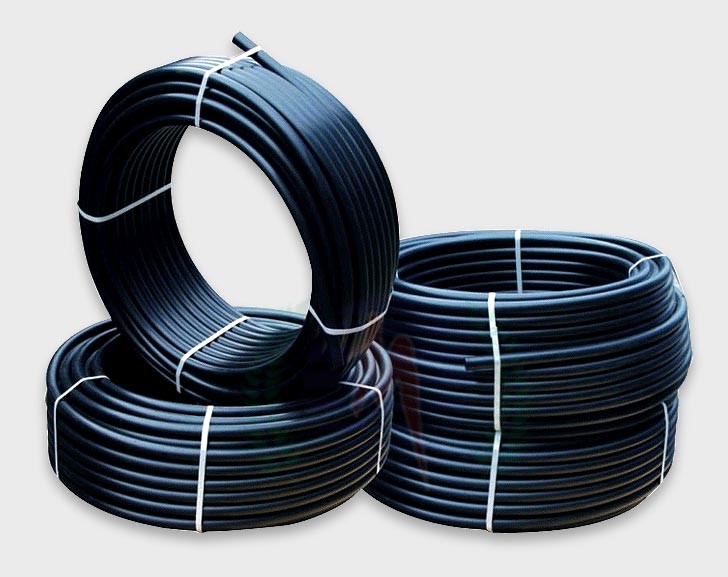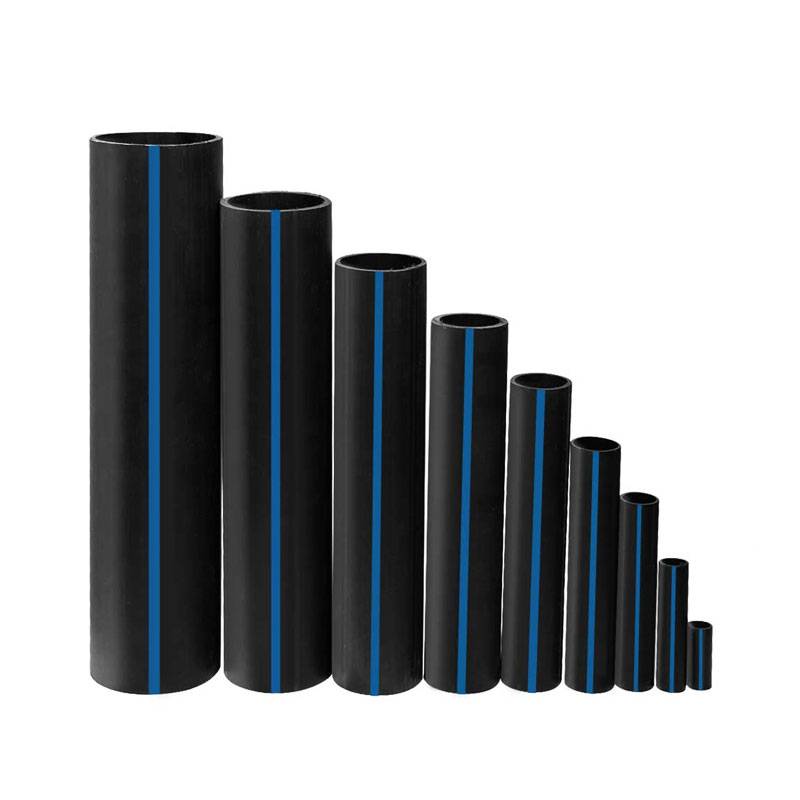American Plastics HDPE Pipe for Oilfield: Preferred in the Oilfield
Wiki Article
Check Out the Production Refine Behind High-Quality HDPE Pipeline and Its Applications
The manufacturing process of high-quality HDPE pipelines is intricate and systematic. It starts with the selection of basic materials that boost efficiency. Following this, ethylene undertakes polymerization to create material, which is after that formed through extrusion. Quality assurance is paramount, making sure that the end product meets strict criteria. Nevertheless, the journey of HDPE pipelines doesn't end with manufacturing. Their applications throughout numerous markets expose a broader value worth taking a look at.Recognizing HDPE: Characteristics and Advantages

High-density polyethylene (HDPE) is a flexible polycarbonate understood for its sturdiness and resistance to numerous ecological variables. This product exhibits superb tensile strength, making it appropriate for demanding applications. Its low-density framework adds to a light-weight item, helping with simplicity of handling and setup. HDPE additionally showcases impressive resistance to chemicals, which minimizes degradation when subjected to extreme materials.
The material's reduced moisture absorption additionally enhances its long life, making it suitable for use in pipes and storage tanks. Furthermore, HDPE is immune to ultraviolet (UV) radiation, making certain that items maintain their honesty also when subjected to sunlight. Its adaptability allows for the creation of detailed shapes without jeopardizing strength. The eco-friendly nature of HDPE, typically acquired from recycled products, contributes to its allure, promoting sustainable methods in production. Overall, these residential or commercial properties and advantages make HDPE a preferred option for numerous commercial and consumer applications.
Raw Material Option for HDPE Manufacturing
The choice of raw products for HDPE production is vital to verify the last item meets the wanted specs and high quality requirements. High-density polyethylene (HDPE) is mostly produced from polymerized ethylene, originated from fossil gas such as all-natural gas or petroleum. The top quality of these feedstocks substantially affects the mechanical and thermal residential properties of the last HDPE.Additives also play a considerable function in enhancing HDPE's efficiency, including anti-oxidants, UV stabilizers, and colorants, which boost durability and resistance to ecological factors. The selection procedure should consider not just the chemical structure of the raw materials yet additionally their processing attributes to ensure efficient production.
Moreover, the sourcing of resources need to focus on sustainability and compliance with environmental regulations, as responsible methods are important in today's market. Eventually, careful resources selection lays the foundation for producing top quality HDPE pipelines suitable for varied applications.
The Extrusion Process: Shaping HDPE Pipeline
The extrusion procedure plays an important duty fit HDPE pipes, beginning with precise product preparation techniques that assure ideal flow and consistency. Equally essential is the design of the die, which directly influences the final measurements and surface quality of the pipe. With each other, these factors contribute considerably to the effectiveness and high quality of HDPE pipe production.Product Preparation Techniques
Effective manufacturing of HDPE pipes starts with meticulous product prep work methods, particularly the extrusion procedure. During this phase, high-density polyethylene material is initial dried to get rid of wetness, guaranteeing excellent flow qualities. The material is after that fed into the extruder, where it goes through heating and melting, changing into a viscous state. This home heating process is thoroughly managed to maintain the material's integrity and performance. The molten HDPE is required with a die, shaping it right into a continual pipe kind. Proper temperature administration throughout extrusion is vital, as it straight affects the product's buildings and the end product high quality. When formed, the HDPE pipeline is cooled down and reduced to specified lengths, prepared for subsequent handling and applications.Die Style Significance
Accuracy in die design plays an important duty in the extrusion procedure of HDPE pipelines. The die functions as the final shaping tool, straight affecting the pipeline's dimensions, wall surface thickness, and surface area coating. A properly designed die warranties consistent product circulation, minimizing issues such as irregularities and weak places. The geometry of the die have to be maximized to suit the details buildings of HDPE, including its viscosity and thermal actions throughout extrusion. Furthermore, the cooling price of the material as it goes through the die can significantly impact the pipe's architectural stability. Consequently, investing in innovative die technology is important for producers aiming to create high-grade HDPE pipes that fulfill sector requirements and client expectations.High Quality Control Actions in HDPE Manufacturing
Various elements influence the top quality of HDPE pipe manufacturing, efficient quality control measures are crucial to ensure uniformity and reliability in the last item (Pipe Supplier American Plastics Midland). Trick quality control techniques consist of rigorous material assessment, validating that the raw polyethylene satisfies well established requirements for pureness and density. During the extrusion process, parameters such as temperature level, pressure, and cooling time are carefully checked to maintain dimensional accuracy and structural honestyIn enhancement, post-production screening is vital; manufacturers often conduct hydrostatic tests to examine the pipeline's toughness and resistance to pressure. Visual examinations for surface area flaws better boost quality control. Certification from relevant requirements companies, like ASTM or ISO, offers an extra layer of reliability. By carrying cpvc to pex adapter out these extensive quality assurance steps, manufacturers can lessen issues, enhance performance, and make sure that the HDPE pipelines satisfy the particular requirements of various applications, inevitably bring about client complete satisfaction and trust in the product.
Applications of HDPE Pipeline Throughout Industries
HDPE pipes are used throughout numerous markets because of their longevity and flexibility. In water circulation systems, they assure efficient delivery, while in wastewater monitoring, they supply trusted services for official website waste transport. Additionally, agricultural irrigation networks take advantage of HDPE's resistance to corrosion and flexibility, making it an ideal option for modern-day farming techniques.
Water Distribution Solutions
A substantial variety of markets depend on high-density polyethylene (HDPE) pipes for efficient water distribution systems. Known for their longevity and resistance to rust, HDPE pipelines are widely utilized in metropolitan water networks, farming irrigation, and industrial applications. Their lightweight nature facilitates very easy handling and setup, minimizing labor prices and time. Furthermore, HDPE pipelines can accommodate various pressure degrees, making them ideal for both low and high-pressure systems. custom hdpe pipe manufacturing Midland TX. The flexibility of the material permits seamless combination into existing framework, decreasing the demand for substantial excavation. Furthermore, HDPE's resistance to chemical seeping warranties that the water delivered remains safe and tidy, making it an ideal choice for keeping the top quality of safe and clean water across numerous sectorsWastewater Management Solutions
Reliable water distribution systems additionally pave the way for ingenious wastewater administration services, where high-density polyethylene (HDPE) pipes play a substantial function. Popular for their sturdiness and resistance to rust, HDPE pipes are perfect for carrying wastewater in various setups. Their flexibility enables for simple setup in complicated atmospheres, minimizing the need for extensive excavation. In addition, HDPE's smooth indoor surface decreases rubbing, enhancing circulation prices and performance. These pipes are likewise resistant to chemical leaching, ensuring that pollutants do not compromise the surrounding environment. Industries, districts, and treatment facilities significantly count on HDPE pipelines for their integrity and durability, making them a preferred choice for contemporary wastewater administration systems. This flexibility emphasizes the critical relevance of HDPE pipes across numerous applications.Agricultural Watering Networks
Agricultural watering networks profit greatly from using high-density polyethylene (HDPE) pipelines, which provide effective and trusted water delivery to crops. HDPE pipes are lightweight, making them very easy to transfer and mount, while their adaptability enables numerous setups in varied terrains. These pipes demonstrate exceptional resistance to deterioration, chemicals, and UV radiation, making sure toughness in harsh agricultural settings. Furthermore, their smooth indoor surface area minimizes rubbing loss, maximizing water circulation and lowering power prices connected with pumping. The durability of HDPE pipelines, usually exceeding half a century, adds to click for source decrease maintenance and replacement expenditures. Consequently, farmers progressively rely upon HDPE pipes to enhance irrigation performance and promote sustainable farming practices, inevitably causing enhanced crop yields and source preservation.Future Trends in HDPE Pipe Modern Technology
As the demand for sustainable and effective infrastructure grows, innovations in HDPE pipe modern technology are positioned to transform different sectors. Arising fads include the assimilation of smart innovations, such as sensors and IoT capacities, which facilitate real-time surveillance of pipe conditions, reducing maintenance expenses and preventing leaks. Additionally, the growth of sophisticated manufacturing methods, such as 3D printing, is allowing the manufacturing of complicated, tailored pipeline styles that cater to details job needs.In addition, the concentrate on recycling and round economic climate practices is driving the development of HDPE pipes made from recycled products, improving sustainability. Improved jointing approaches, such as electro-fusion and mechanical fittings, are additionally improving installment performance and dependability. Ultimately, the expanding focus on environmental policies is pushing producers to take on greener production processes, ensuring that HDPE pipelines not just satisfy sector requirements but also promote an even more lasting future for framework growth.
Regularly Asked Concerns
Just How Does HDPE Compare to Various Other Plastic Products?
HDPE outshines several various other plastic materials relating to resilience, chemical resistance, and versatility. Its reduced density and high tensile toughness make it optimal for different applications, frequently exceeding options in both efficiency and durability.What Are the Environmental Impacts of HDPE Production?
The ecological effects of HDPE production include greenhouse gas exhausts, energy consumption, and potential air pollution from making procedures. Additionally, improper disposal can bring about dirt and water contamination, elevating concerns about lasting ecological impacts.Can HDPE Pipes Be Recycled?
Yes, HDPE pipes can be reused. Many centers approve made use of HDPE for processing, transforming it right into new items. This recycling contributes to sustainability initiatives, lowering plastic waste while saving sources and energy in the manufacturing cycle.What Is the Life Expectancy of HDPE Piping?

How Do Temperature Level Variations Influence HDPE Pipeline Performance?
Temperature variants greatly affect HDPE pipe efficiency, influencing adaptability and stamina. High temperature levels can bring about softening, while reduced temperature levels might trigger brittleness, ultimately influencing the pipe's toughness and suitability for different applications in diverse settings.Report this wiki page